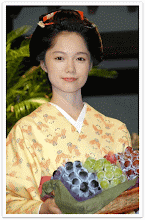One hundred forty five years ago saw
the Surrender of Edo Castle and thus ending two hundred sixty six
years of Tokugawa rule. The decision to surrender was made by Katsu
Kaishu in an effort to avoid any pointless bloodshed. With Shogun
Yohinobu's abdication and the threat of annihilation by the
encroaching forces of the newly minted Imperial Army under Satsuma's
Saigo Takamori, it was Kaishu who sought a meeting with Saigo
Takamori to negotiate a peaceful settlement. It's often overlooked
yet not entirely forgotten credit for both the bloodless surrender
and the survival of the Tokugawa family is the role of Lady Tenshoin,
the widow of the 13
th Shogun Iesada. It is said that she
contributed to the negotiations to appeal to Takamori's heart so that
the Tokugawa's could survive. Her contribution was widely depicted in
the 47
th NHK Taiga Drama
Atsuhime.

Upon receipt of a
written letter from Kaishu, Imperial Commander Saigo Takamori agreed
to meet with Kaishu one day before the planned attack on Edo Castle.
They met on March 14th 1868 and reached a peaceful
settlement paving the way for Japan to enter the Meiji Era and the
modern world. The Boshin War as it was known dragged on for another
year by die hard loyalists who retreated to the north forming the
short lived Republic of Ezo until their defeat at Hakodate in 1869,
the year the Samurai World had come to an End.
So what of the players of this real
life drama?
For Lady Tenshoin better known to modern audiences as Princess Atsu or Atsuhime, her life would
continue nurturing the Tokugawa heir Iesato until her quiet death
from Parkinson's disease at the relatively young age of 49 in 1883. Had she not played
her part, Edo Castle would have been turned into a blood bath and a
certain heir to the Tokugawa family who in another life would be
today's Shogun would not be alive today teaching as a professor in
present day Chicago. She is entombed next to Shogun Iesada. As much as she was at the time of her death, she had thousands line the streets for her funeral procession. After the airing of the 47th NHK Taiga drama, the cemetery housing her tomb was temporarily opened to the public for three days in a most unprecedented move by Japanese standards as grave viewings are not part of Japanese Culture as they are in the West. Over ten thousand people came to visit, many of them weeping.

Katsu Kaishu continued to live on and
became part of the New Meiji Government continuing his work
developing a modern Navy. His was a most fascinating life starting
with his famous voyage to America in 1860 aboard the Kanrin Maru as
it's captain, to the forming of the first Shogunate Naval Academies,
to the mentor ship of legendary reformer and father of modern Japan Sakamoto Ryoma of Tosa. His
role in Japan's entry into the modern world could not be any more
understated nor should it be overlooked by any means. Before his death, he had been elevated to the Imperial Court as Hakushaku or Count. His memoirs are contained in the book Hikawa Seiwa. He died an Elder Statesman 1899 but not forgotten by history or in our hearts. On our own cruise of San Francisco Bay on the 150th Anniversary of the Kanrin Maru's voyage to San Francisco, we followed the actual footsteps of Katsu Kaishu and for a moment we were sure his spirit was there with us.

As for Imperial Commander Saigo
Takamori of the Satsuma Domain, Irony was not without it's fate. The very man who played a principle
role in that end would rise up eight years later and stage the
Satsuma Rebellion which ended any notion that Samurai privilege could
be restored in modern Japan. Saigo Takamori was killed in the final
battle of the Satsuma Rebellion in 1877, a futile struggle that
became the inspiration for the fictional Samurai tale from Hollywood 2003's The Last Samurai. In an unrelated Irony, the name
The Last Samurai was given to the first film made in 1974 depicting the Satsuma Rebellion. Why Hollywood chose to recycle the title is beyond reason. A more recent depiction of Saigo's tragic Rebellion and bloody end can be seen depicted in the more recent film
Hanjiro.
It's estimated that during the two year
war some six thousand men died fighting for Japan many of them
enshrined at the Yasukuni Shrine located in Chiyoda, Tokyo. To find out more or to visit this privately funded Shinto Shrine please visit
Yasukuni Shrine.

































